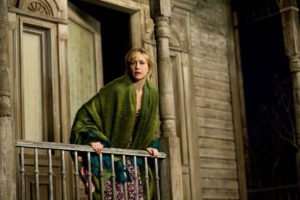“I stumbled into genre film a few years ago,” Mark S. Freeborn chuckled. But the stumbles have all been good ones, as he notes “I’ve been very fortunate in that most of the genre elements have been of superior quality and direction.”
That pedigree includes work for X-Files creator Chris Carter on series like The Lone Gunmen and Millennium, the Halloween-themed cult fave Trick ‘r Treat, and more recently, not only the X-Files’ return, but a show where the motels were more often used to cook meth, rather than slaughter shower-takers, called Breaking Bad.
Now, though, he’s logged five seasons with the happy Bates clan and their roadside inn, counting himself a “big fan of the original” film
And he mentioned show co-producer Justis Greene as “a man I’d known for years, but never been able to collaborate with.”

But he was still daunted, knowing he had “stiff competition from the previous designers; several iterations of the Bates Motel,” including, he notes, the legendary Henry Bumstead, who took a stab at the iconic buildings, so to speak, for the Anthony Perkins-directed Psycho III.
Once “Bummy’s” name comes up, however, the conversation veers quickly to the greatness of To Kill a Mockingbird’s design, a film which Freeborn lists as among his five favorites.
But returning to the Bateses, he says, the challenge was that this wasn’t simply an additional film, but a long-running series, so sets “had to be built and designed to be more flexible.”
But of course it wasn’t just the family business, but their adjacent house, which needed to be included — a dwelling that “was as large a character as anyone in the film.”
“We searched for a lot of months for the proper location — and ended up ironically on a decommissioned landfill. But it had the the right contours of relation between the house and motel.”
So Freeborn “started from there. It was a challenge. I needed to do at least as well as my predecessors.”
But he had those aforementioned practicalities to look after: “We also tried to make the house as shootable as possible, so the rooms are pushed as large as we can make them, without making the house look freakishly over-scaled.”
But like any good character, the house evolves. “Without giving away the whole concept, Norm is now in the house alone. It’ll get darker in some ways. We’ve now got plans to extend into the attic a little bit, too.”
Of Norman, he says “he will never lose that part of his mother that keeps the place tied in,” but of course holding “part” of someone close is a problematic image in the world of the Bates family. But that’s what Freeborn likes about it.
The experience for him, he says, is “about imagining, amplifying the terror.” After all, “you can do apartments and classrooms all day along.”
It’s when night rolls around — and the neon signs of the dark motels start flickering on — that things start to get all-too-interesting.





